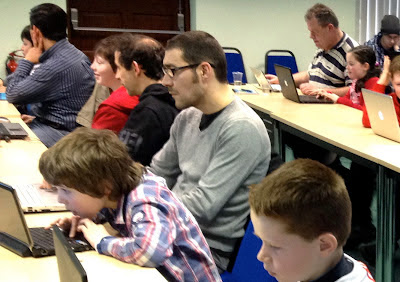Panel in the Computer and Communications Museum of
Ireland, DERI, NUI Galway
A special event
in NUI Galway on Friday will celebrate the 40th anniversary of the
birth of popular computer gaming when the Computer and Communications Museum of
Ireland, located in the Digital Enterprise Research Institute (DERI), will host
a ‘Retro Games’ extravaganza.
Members of the general public are invited along to enjoy the wonders
of classic games including Asteroids, Pacman, Space Invaders, Sonic the
Hedgehog and Earthworm Jim on legendary consoles and computers such as the Sega
Mega Drive, Nintendo, Atari, Amiga
and the Commodore 64.
The sights and
sounds on offer will capture the essence of the early days of computer gaming
of the 1970s and 1980 which made a major contribution in the overall development
of digital sound and graphics.
Of particular significance will be the showing
of ‘Pong’, the first commercially successful video game, released in 1972 by a then
new American company called Atari Inc. which was primarily responsible for the
formation of the computer game and video arcade industries.
Attendees will
also be introduced to the software coding that constitutes the games and will
be able therefore to gain an insight into how digital technology actually
works.
There will also
be displays of American and European 1960s science fiction comics and
memorabilia including Star Trek, Thunderbirds, Green Lantern, Thor and the Avengers. Today's children can relate to many of these fictitious characters as they are making a welcome return to modern day cinema.
1960s Science Fiction Comics:
Influencing Social Change & Inspiring Scientific &
Technology Innovation
Science Fiction has inspired generations of young people to invent
future technologies from robotics to space stations.
This was particularly
evident in the 1960s when manned space travel began with Soviet cosmonaut Yuri Gagarin becoming the first human to
journey into outer space on 12th April 1961. Before the decade had ended, mankind
had landed on the Moon.
On July 20th 1969,
American astronauts Neil Armstrong and Buzz Aldrin stepped onto its surface
from the Lunar module Eagle.
Space travel captured the imagination of youth and the 1960s witnessed
an explosion of popular science fiction worldwide that embraced comics, films,
television programmes and toys.
In the United States, Marvel
and DC comics created a myriad of
super–heroes that appealed to a young readership because of their exciting
adventures across distant galaxies that promised an often benign future where
interplanetary travel would become a characteristic of high tech societies.
For the first time, children read about civilisations where women as well as boys and girls particularly teenagers fought
battles for truth and justice.
Females heroines such as Wonder Woman and
teenagers such as Saturn Girl and the
X-Men were as prominent in science
fiction as adult males such as Iron Man
and Hawkman.
For the first time, super-heroes did not have to have by definition the
perfect physiques. A number of the genre had disabilities such as blindness (Daredevil) and heart defects (Iron Man).
There was a realisation too that mankind’s attitudes and technologies
were endangering the health of the planet, the destruction of other species and
of humanity itself. This environmental message features prominently in comics
such as the Sub Mariner and in films
such as the Planet of the Apes (1969)
and Soylent Green (1973).
In recent years, there has been a remarkable rebirth in these classic
super heroes thanks to CGI (Computer-generated imagery). Films such as Thor and Green Lantern were box-office
successes in 2011 and this year sees the return of the Avengers.























